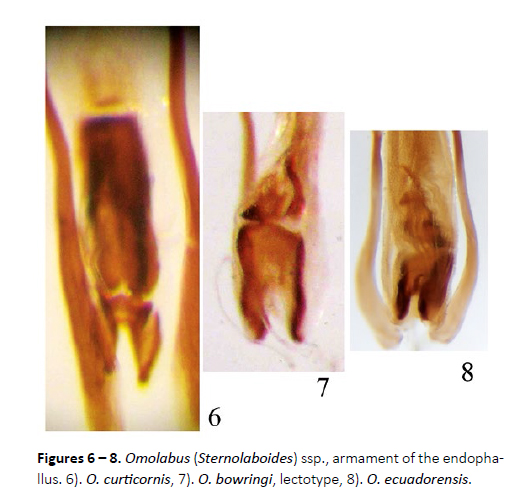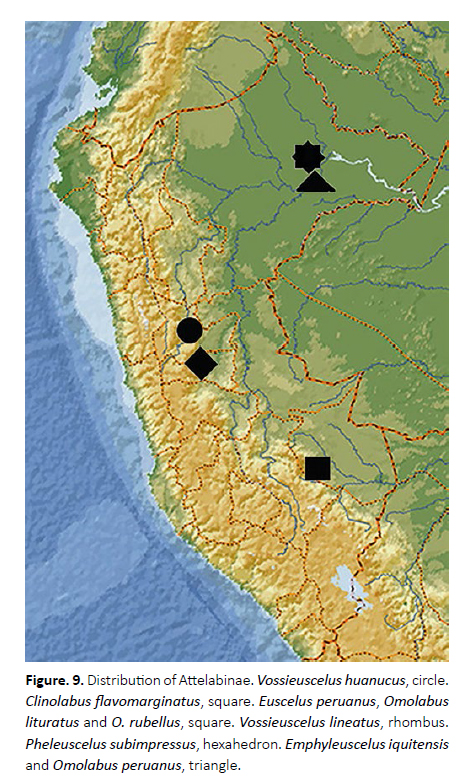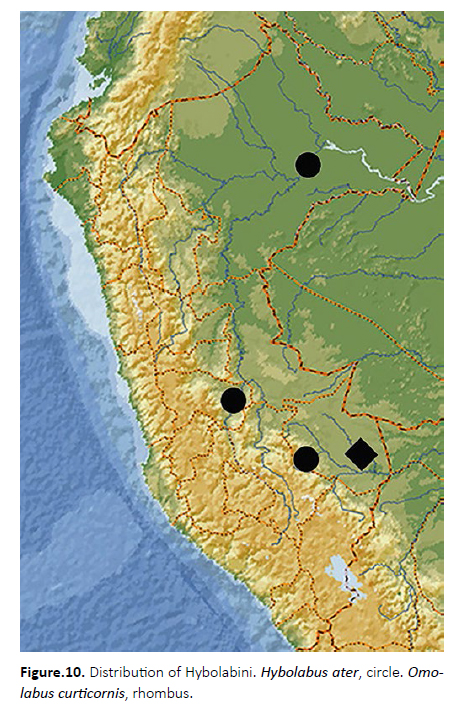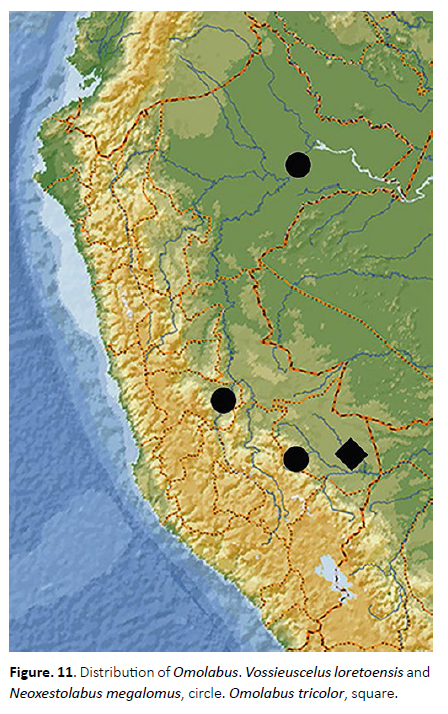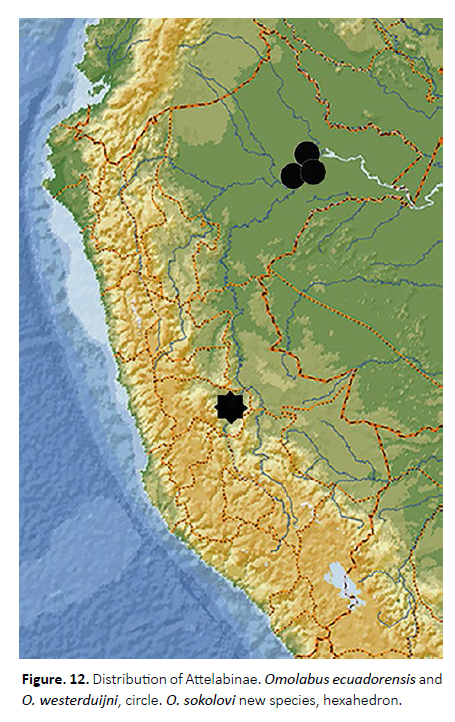Servicios Personalizados
Revista
Articulo
Indicadores
-
 Citado por SciELO
Citado por SciELO
Links relacionados
-
 Similares en
SciELO
Similares en
SciELO  uBio
uBio
Compartir
Revista Peruana de Biología
versión On-line ISSN 1727-9933
Rev. peru biol. vol.26 no.1 Lima ene./mar. 2019
http://dx.doi.org/10.15381/rpb.v26i1.15908
TRABAJOS ORIGINALES
Beetles (Coleoptera) of Peru: A Survey of the Families. Attelabidae Billberg, 1820
Escarabajos (coleópteros) de Perú: un reconocimiento de las familias. Attelabidae Billberg, 1820
Andrei A. Legalov 1, 2
1 Institute of Systematics and Ecology of Animals of the Siberian Branch of the Russian Academy of Sciences, Russia
2 Altai State University, Russia
Abstract
A new species, Omolabus (Sternolaboides) sokolovi Legalov n. sp. from Satipo, Central Peru, is described. New data for Hybolabus ater (Olivier, 1789), Omolabus (Perulabus) peruanus Legalov, 2004, O. (Pseudomolabus) westerduijni Legalov, 2008 and O. (Sternolaboides) ecuadorensis Legalov, 2007 are recorded. A verified species checklist of Peruvian Attelabidae based on literature and specimen examinations is presented. Distributions of 18 species from eight genera of two tribes found in the fauna of Attelabidae from Peru are given.
Keywords: Curculionoidea; leaf-rolling weevils; Attelabinae; new species; South American biodiversity; checklist.
Resumen
Se describe una nueva especie, Omolabus (Sternolaboides) sokolovi Legalov n. sp. de Satipo, centro de Perú. Se registran nuevos datos para Hybolabus ater (Olivier, 1789), Omolabus (Perulabus) peruanus Legalov, 2004, O. (Pseudomolabus) westerduijni Legalov, 2008 y O. (Sternolaboides) ecuadorensis Legalov, 2007. Basada en la literatura y exámenes de muestras, se elabora una lista de las 18 especies peruanas de Attelabidae, pertenecientes a ocho géneros de dos tribus, tambien se presentan sus distribuciones en Perú.
Palabras clave: Curculionoidea; Attelabinae; Biodiversidad sudamericana; especie nueva; Listado de especies.
Introduction
Curculionid beetles have been poorly studied in Peru. There are many separate descriptions of species (Erichson 1847; Kirsch 1874; Voss 1954; Howden 2001; Hespenheide 2018; etc.). General information about the species of Peru is provided by Wood and Bright (1992), Wibmer and O'Brien (1986), Rheinheimer (2004), and Sforzi and Bartolozzi (2004). Recently, checklists of some groups (Brentidae, Scolytinae, Platypodinae) were compiled as part of the ‘Beetles of Peru’ (see Chaboo 2015; Kirkendall 2017; Mantilleri et al. 2017; Smith et al 2017).
The leaf-rolling weevils, or family Attelabidae, are geographically widespread (Legalov 2007, 2008a, 2008b, 2010) and currently comprise more than 170 genera and about 1300 species in the world. Attelabidae includes two subfamilies, Attelabinae and Apoderinae and it is represented in the New World by the subfamily Attelabinae with three tribes. Data on Attelabidae from Peru are published by Kirsch (1874), Voss (1925, 1929, 1937), Legalov (2004, 2007, 2008a) and Hamilton (2005).
As their common name suggests, leaf-rolling weevils actually cut leaves of host trees and roll the leaves into tubes (called "nidus") where they live and eat. The adult cuts the mid-rib of the leaf, lets it go limp, then bits along the lower surface to make notches where it folds the leaf with its legs (Kôno 1930; Legalov 2007). The largest number of species of Attelabidae examined develops on cosmopolitan and tropical plant families. In all the zones, the richest fauna of Attelabidae was found on representatives of such widespread families as Rosaceae and Fagaceae, and also on cosmopolitan Betulaceae. Fagaceae, Myrtaceae, and Lauraceae are very important food sources for tropical species (Legalov 2005). Biology of Attelabidae is summarized in Legalov (2007).
The genus Omolabus includes 76 species distributed in Central and South America but absent in the West Indies (Voss 1925; Hamilton 2005; Legalov 2007, 2008b). Species of the genus have been reproductively associated with plants from families Anacardiaceae, Myrtaceae, Tiliaceae and Euphorbiaceae (Voss, 1953; Hamilton 2005). Larvae develop in curled fragments of leaves (Wheeler et al. 2013).
In this article, I describe a new species and present the first checklist of the Attelabidae of Peru. This is another installment in Caroline Chaboo’s Beetles of Peru’ project.
Material and methods
The studied specimens are kept at the Museo de Historia Natural, San Marcos University (Peru: Lima) MUSM, Institute of Systematic and Ecology of Animals (Russia: Novosibirsk) ISEA, collection of A.V. Korshunov (Russia: Kemerovo) KKC, collection of E.V. Obidin (Kazakhstan: Temirtau) EOC, Zoological Museum of Moscow State University (Russia: Moscow) ZMM, Lund University (Sweden: Lund); Museo Civico di Storia Naturale "Giacomo Doria" (Italy: Genova), Museum für Tierkunde, Senckenberg Naturhistorische Sammlungen Dresden (Germany: Dresden), Natural History Museum (UK: London); Petr Kresl Collection (Czech Republic: Janovice nad Uhlavou), Zoological Institute of Russian Academy of Sciences (Russia: St. Petersburg). Description, body measuring, and photographs were performed using the Zeiss Stemi 2000-C dissecting stereomicroscope.
Results
Nineteen species from eight genera of two tribes are documented for the fauna of Attelabidae from Peru. Below, I describe a new species based on 9 specimens. Locality records for all 18 species now documented in Peru are available in the original citations. Future field collections and study of specimens from more museums may uncover more diversity.
Description of new species
Omolabus (Sternolaboides) sokolovi Legalov, new species (Figs. 1 ‒ 5)
Diagnosis. The new species is very similar to Omolabus (Sternolaboides) bogotensis Legalov, 2007 from Colombia but differs in the elytra weakly narrowed to apex and wider pronotum. It is distinguished from O. (S.) ecuadorensis in the distinct dorsal posthumeral humplike protuberance on the elytra, weaker convex pronotum and form (narrow and long) of the basal sclerite of the endophallus.
Description. Body black, lustrous, naked. Pronotum usually brownish or brown.
Male: Head conical, elongate, distinctly widened at base. Rostrum quite long, arcuate, widened to apex, densely punctate, with two longitudinal striae from antennal insertion to base, with apico-lateral denticulate on each side. Antennae inserted near middle dorso-laterally. Eyes large, oval, weakly convex. Forehead narrow, weakly concave, sparsely punctate. Temples elongate, weakly transversely wrinkled. Vertex flattened, finely transversely wrinkled. Antennae long, reaching temples. Antennomere 1 oval. Antennomere 2 oval, slightly shorter and narrower than antennomere 1. Antennomeres 2-8 conical. Antennomere 3 shorter and narrower than antennomere 2. Antennomere 4 shorter and equal in wide to antennomere 3. Antennomere 5 shorter and slightly wider than antennomere 4. Antennomere 6 slightly shorter than Antennomere 5. Antennomere 7 slightly wider than antennomere 6. Antennomere 8 distinctly wider than Antennomere 7. Club compact, 0.6 times as long as antennomeres 1 ‒ 8 combined. Antennomeres 9 and 10 subequal. Antennomere 11 distinctly wider than antennomere 10.
Pronotum almost conical, widest at base. Sides almost straight. Disk convex, sparsely punctate, near slightly transversely wrinkled. Scutellum almost rectangular, wide.
Elytra slightly longer than wide, with dorsal posthumeral hump-like protuberance. Greatest width in humeri. Humeri strongly convex. Intervals flat, almost smooth. Striae distinct, without deep points.
Precoxal portion of prosternum long, transversely wrinkled, concave in middle. Procoxal cavities contiguous. Postcoxal portion short. Metaventrite slightly longer than metacoxa. Metanepisternum wide, finely punctate. Metepimera wide-triangular, punctate.
Abdomen convex, punctate. Ventrites subequal in lenghth. Pygidium convex, densely punctate.
Legs long. Forelegs elongated. Profemora enlarged. Protibiae long, weakly curved, with long mucro. Mesoand metatibiae shorter, weakly biconcave, weakly expanded to apex. Tarsi long. Tarsomere 1 long-conical, longer than tarsomere 2. Tarsomere 2 wide-conical, flattened. Tarsomere 3 bilobed. Tarsomere 5 elongate. Claws long, fused at base.
Length of body (without rostrum): 5.2 ‒ 6.0 mm. Length of rostrum: 1.1 ‒ 1.4 mm.
Female: Rostrum shorter. Prementum without tooth. Antennae inserted closer to rostrum base. Temples shorter. Precoxal part of prosternum shorter. Tibiae with mucro and premucro. Protibiae shorter and wider.
Length of body (without rostrum): 4.7 ‒ 5.4 mm. Length of rostrum: 0.8 ‒ 1.1 mm.
Type material. Holotype, male (MUSM), PERU, Junin Dep., Satipo Prov., near Rio Venado vill., 11˚11'787"S, 74˚46'168"W, 1122 m, 23.XI-6.XI.2014, A. Sokolov. Paratype: female (ISEA), female (MUSM), idem; male (EOC), idem, 21.X.2013; 4 males (ISEA), female (EOC), 22.IX18.X.2017, idem; female (ISEA), female (KKC), idem, 1528.I.2016, A. Korshunov; female (ZMM), Satipo env., Calabaza vill., 2500 m, V.2004, A. Sokolov.
Etymology. The species named in honour of Dr. Alexander V. Sokolov (Russia), who collected this species.
Remarks. The new species belongs to the genus Omolabus based on the femora without teeth of males and weakly convex eyes. It is placed in the subgenus Sternolaboides Legalov, 2007 because the humeri without tooth, apex of the elytra without blades, pronotum without protuberance or tooth near apex, rostrum shorter than pronotum, and the basal sclerite of the endophallus almost symmetric.
Key to Species of Subgenus Sternolaboides
1. Elytra with distinct dorsal posthumeral hump-like protuberance.
2
-. Elytra without dorsal posthumeral hump-like protuberance. 3
2. Elytra weakly narrowed to apex. Pronotum wider, width in middle 1.5 times as long as length. Peru.
Omolabus sokolovi Legalov, new species
-. Elytra more narrowed to apex. Pronotum narrower, width in middle 1.4 times as long as length. Colombia.
Omolabus bogotensis Legalov, 2007
3. Elytra narrowed to apex. Brazil.
Omolabus curticornoides Legalov, 2007
-. Elytra almost rectangular. 4
4. Pronotum more densely punctate, with two impressions. Brazil.
Omolabus niger Legalov, 2007
-. Pronotum smooth or sparsely punctate. 5
5. Eyes slightly convex. Protibia wider. Bolivia.
Omolabus bolovicus Legalov, 2007
-. Eyes stronger convex. Protibia narrower. 6
6. Pronotum slightly narrowed to apex. Armament of endophallus (Fig. 8). Ecuador, Peru. Omolabus ecuadorensis Legalov, 2007
-. Pronotum strongly narrowed to apex. 7
7. Pronotum stronger narrowed to apex. Armament of endophallus (Fig. 6). Columbia, Peru. Omolabus curticornis Voss, 1929
-. Pronotum weaker narrowed to apex. Armament of endophallus (Fig. 7). Brazil. Omolabus bowringi Voss, 1938
Hybolabus ater (Olivier, 1789)
Material. female (KKC), PERU, Junin Dep., Satipo Prov., near Rio Venado vill., 11˚11'787"S, 74˚46'168"W, 1122 m, 15-28.I.2016, A. Korshunov; male (ISEA), PERU, Loreto, Padre Cocha, 20.I.2007, R. Westeruijn.
Omolabus (Perulabus) peruanus Legalov, 2004
Material. Male (ZMM), PERU, Iquitos env., Botanical garden, 5-8.VI.2004, A. Sokolov.
Omolabus (Pseudomolabus) westerduijni Legalov, 2008
Material. Female (ZMM), PERU, Iquitos env., Botanical garden, 5-8.VI.2004, A. Sokolov.
Omolabus (Sternolaboides) ecuadorensis Legalov, 2007
Material. Female (ZMM), PERU, Iquitos env., Botanical garden, 5-8.VI.2004, A. Sokolov.
Check list
Tribe Euscelini Voss, 1925
Subtribe Clinolabina Legalov, 2003
Genus Clinolabus Jekel, 1860
1. Clinolabus flavomarginatus Voss, 1925 (Fig. 9, Madre de Dios, square) =Clinolabus boliviensis Janczyk, 1960
Subtribe Euscelina Voss, 1925 Genus Vossieuscelus Legalov, 2007
2. Vossieuscelus huanucus (Legalov, 2004) (Fig. 9, Huánuco, circle)
3. Vossieuscelus lineatus (Voss, 1925) (Fig. 9, Pasco, Huánuco, rhombus) = Euscelus lineatus f. geniculata Voss, 1937
4. Vossieuscelus loretoensis Legalov, 2008 (Fig. 11, Loreto, circle)
Genus Alleuscelus Voss, 1937
5. Alleuscelus (Alleuscelus) violaceipennis Voss, 1937
Genus Euscelus Schoenherr, 1833
6. Euscelus (Meteusceliodes) peruanus Voss, 1925 (Fig. 9, Madre de Dios, square)
Genus Pheleuscelus Jekel, 1860
7. Pheleuscelus (Pheleusceloides) subimpressus (Voss, 1925) (Fig. 9, Loreto, hexahedron) = Euscelus subimpressus f. testaceicornis Voss, 1937
Genus Emphyleuscelus Voss, 1925
8. Emphyleuscelus (Emphyleuscelus) iquitensis (Legalov, 2004) (Fig. 9, Loreto, triangle)
Tribe Hybolabini Voss, 1925
Subtribe Hybolabina Voss, 1925
Genus Hybolabus Jekel, 1860
9. Hybolabus ater (Olivier, 1789) (Fig. 10, Loreto, circle)
= Attelabus atratus Fabricius, 1801
= Attelabus cupripennis Perty, 1832
= Attelabus variabilis Gyllenhal, 1833
= Attelabus sallei Jekel, 1860
= Hybolabus ater ssp. peruanus Voss, 1925
= Hybolabus ater f. ruficollis Voss, 1938
Subtribe Omolabina Legalov, 2003
Genus Neoxestolabus Voss, 1943
10. Neoxestolabus (Hamiltonilabus) megalomus (Hamilton, 2005) (Fig. 11, Loreto, circle)
Genus Omolabus Jekel, 1860
11. Omolabus (Perulabus) peruanus Legalov, 2004 (Fig. 9, Loreto, triangle)
12. Omolabus (Pseudomolabus) tricolor (Kirsch, 1874) (Fig. 11, Pasco, Huánuco, square)
13. Omolabus (Pseudomolabus) westerduijni Legalov, 2008 (Fig. 12, Loreto, circle)
14. Omolabus (Paralabus) lituratus Voss, 1938 (Fig. 9, Madre de Dios, square)
15. Omolabus (Xestolabus) rubellus (Voss, 1925) (Fig. 9, Madre de Dios, square)
16. Omolabus (Sternolaboides) sokolovi Legalov, new species (Fig. 12, Junín, hexahedron)
17. Omolabus (Sternolaboides) curticornis Voss, 1929 (Fig. 10, Madre de Dios, rhombus)
18. Omolabus (Sternolaboides) ecuadorensis Legalov, 2007 (Fig. 12, Loreto, circle)
Acknowledgements
I am grateful to M.V.L. Barclay (UK: London), R. Danielsson (Sweden: Lund), O. Jaeger (Germany: Dresden), K.-D. Klass (Germany: Dresden), A.V. Korshunov (Russia: Kemerovo), B.A. Korotyaev (Russia: St. Petersburg), P. Kresl (Czech Republic: Janovice nad Uhlavou), N.B. Nikitsky (Russia: Moscow), E.V. Obidin (Kazakhstan: Temirtau), R. Poggi (Italy: Genova), A.V. Sokolov (Russia: Moscow), for the opportunity to study the material and to J. M. Morrone for his reviewing of the manuscript. I also thank Caroline Chaboo for motivating the study and commenting on an early draft.
Citación:
Legalov A.A. 2019. Beetles (Coleoptera) of Peru: A Survey of the Families. Attelabidae Billberg, 1820. Revista peruana de biología 26(1): 033 040 (Febrero 2019). doi: http://dx.doi.org/10.15381/rpb.v26i1.15908
Publicación registrada en Zoobank/ZooBank article registered:
LSIDurn:lsid:zoobank.org:pub:6C34BBEA-04C7-446B-8327-64F1A2FC0885
Acto nomenclatural/nomenclatural act:
LSIDurn:lsid:zoobank.org:act:F19261C5-A71F-48B1-B5C9-C868736B0AE9
Literature Cited
Chaboo CS 2015. Beetles (Coleoptera) of Peru: A survey of the families. Part I. Overview. Journal of the Kansas Entomological Society 88 (2): 135–139. DOI: 10.2317/0022-8567-88.2.135 [ Links ]
Erichson GF 1847. Conspectus Insectorum Coleopterum, quae in republica Peruana observata sunt. Archiv for Naturgeschichie 13: 67–185. [ Links ]
Hamilton RW 2005. Omolabus Jekel (Coleoptera: Attelabidae) in north and central America. Zootaxa 986: 1–60. [ Links ]
Howden AT 2001. A new species of Pandeleteius from Peru. Revue Francaise d' Entomologie 23 (2): 171–175. [ Links ]
Kirkendall LR 2017. Beetles (Coleoptera) of Peru: a survey of the families. Curculionidae: Platypodinae. The Coleopterists Bulletin 71 (1):99-115. DOI: 10.1649/0010065X-71.1.99 [ Links ]
Kirsch T 1874. Beitrage zur Kenntniss der Peruanischen Kaferfauna auf Dr. Abendroth’s Sammlungen basirt. Berliner Entomologische Zeitschrift 18 (3–4): 385–432.
Kôno H 1930. Die biologischen Gruppen der Rhynchitinen, Attelabinen und Apoderinen. Journal of the Faculty of Agriculture, Hokkaido Imperial University. Sapporo 29 (1): 1–36. [ Links ]
Legalov AA 2004. New data of the leaf-rolling weevils (Coleoptera: Rhynchitidae, Attelabidae) of the world fauna with description of 35 new taxons. Baltic Journal of Coleopterology 4 (1): 63–88. [ Links ]
Legalov AA 2005. Trophic links of leaf-rolling weevils (Coleoptera, Rhynchitidae and Attelabidae). Entomological Review 85 (4): 361–370. [ Links ]
Legalov AA 2007. Leaf-rolling weevils (Coleoptera: Rhynchitidae, Attelabidae) of the world fauna. Novosibirsk: Agro-Siberia. 523 p. [ Links ]
Legalov AA 2008a. To the knowledge of the leaf-rolling weevils of subfamily Attelabinae (Coleoptera, Attelabidae). Altaiskii Zoologichesky Zhurnal 2: 69–77, 80–82. [ Links ]
Legalov AA 2008b. To the knowledge of Attelabid-beetles (Coleoptera) of the world fauna // Acta biologica Universitatis Daugavpiliensis. Acta biologica Universitatis Daugavpiliensis 2 (2): 193–226. [ Links ]
Legalov AA 2010. Contribution to the knowledge of the leaf-rolling weevils (Coleoptera, Rhynchitidae, Attelabidae). Amurskii Zoologicheskii Zhurnal 2 (1): 13–38, I–X. [ Links ]
Mantilleri A, L Bartolozzi & A Sforzi. 2017. Brentidae of Peru (Coleoptera: Curculionoidea). Zootaxa 4221 (1): 60. DOI: http://dx.doi.org/10.11646/zootaxa.4221.1.2 [ Links ]
Rheinheimer J 2004. Illustrierter Katalog und Bibliographie der Anthribidae der Welt (Insecta: Coleoptera), Mitteilungen des Entomologischen Vereins Stuttgart 39: 1–288. [ Links ]
Sforzi A & L Bartolozzi 2004. Brentidae Billberg, 1820 (Brentinae, Cyphagoginae, Pholidochlamydinae, Taphroderinae, Trachelizinae, Ulocerinae) (Coleoptera, Curculionidae). Brentidae of the World (Coleoptera, Curculionoidea). Regione Piemonte, Museo Regionale di Scienze Naturali, Monografie 39: 19–828. [ Links ]
Smith SM, AV Petrov & AI Cognato. 2017. Beetles (Coleoptera) of Peru: a survey of the families. Curculionidae: Scolytinae. The Coleopterists Bulletin 71(1):77-94. DOI: 10.1649/0010-065X-71.1.77 [ Links ]
Voss E 1925. Die Unterfamilien Attelabinae und Apoderinae (Col. Curc.) (18. Beitrag zur Kenntnis der Curculioniden). Stettiner Entomologische Zeitung 85 (1–2): 1–78, 191–304. [ Links ]
Voss E 1929. Einige bisher unbeschriebene Rhynchitinen der palaarktischen Region (Col. Curc.) (27. Beitrag zur Kenntnis der Curculioniden). Entomologische Blatter 26: 24–29. [ Links ]
Voss E 1937. Beschreibung neu bekannt gewordener Attelabinen aus der neotropischen Region (Col.) (60. Beitrag zur Kenntnis der Curculioniden). Revista de Entomologia 7(2–3): 154–164. [ Links ]
Voss E 1953. Curculionidae: Oxycoryninae, Belinae, Archolabinae, Attelabinae, Apoderinae. Coleopterororum Catalogus. Supplementa ad partes 144 et 110: 1–19, 1–34. [ Links ]
Voss E 1954. Curculionidae (Col.). Beitrage zur Fauna Perus 4. Jena: 13–364. [ Links ]
Wheeler GS, Mc Kay F, Vitorino MD, Williams D A 2013. Biology and host range of Omolabus piceus, a weevil rejected for biological control for Schinus terebinthifolius in the USA. BioControl 58 (5): 693–702. [ Links ]
Wibmer GJ & O'Brien CW 1986. Annotated checklist of the weevils (Curculionidae sensu lato) of South America (Coleoptera: Curculionoidea). Memoirs of the American Entomological Institute 39: i–xvi, 1–563. [ Links ]
Wood SL & DE Bright 1992. A catalog of Scolytidae and Platypodidae (Coleoptera), Part 2: Taxonomic index. Great Basin Naturalist Memoirs 13: 1–1553. [ Links ]
Correspondencia:
1. Institute of Systematics and Ecology of Animals of the Siberian Branch of the Russian Academy of Sciences, Frunze str., 11, Novosibirsk 630091, Russia
2. Altai State University, Lenina str., 61, Barnaul 656049, Russia
Email Andrei Legalov: fossilweevils@gmail.com
Presentado: 23/09/2018
Aceptado: 29/01/2019
Publicado online: 18/03/2019














